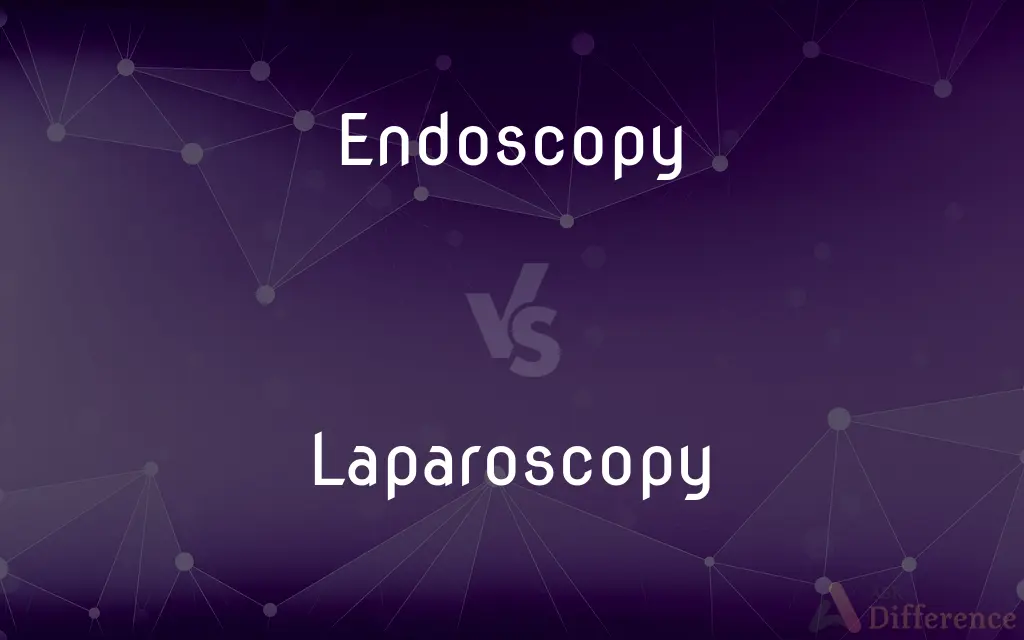Endoscopy vs. Laparoscopy — What's the Difference?
Edited by Tayyaba Rehman — By Fiza Rafique — Updated on September 29, 2023
Endoscopy is a non-surgical procedure using a flexible tube to view inside the body, while laparoscopy is a minimally invasive surgical technique viewing the abdominal or pelvic region.

Difference Between Endoscopy and Laparoscopy
Table of Contents
ADVERTISEMENT
Key Differences
Endoscopy and laparoscopy serve different medical purposes. Endoscopy is predominantly diagnostic, allowing physicians to view the inside of the body's hollow structures like the stomach or colon. Laparoscopy, however, is both diagnostic and therapeutic, primarily used for surgical interventions within the abdomen or pelvis.
The instruments used in endoscopy and laparoscopy differ. Endoscopy typically employs a flexible tube called an endoscope, with a light and camera attached to visualize inner parts of the body. In contrast, laparoscopy uses a laparoscope, a rigid tube equipped with a camera, which is introduced through small incisions in the abdomen.
The anatomical regions targeted by endoscopy and laparoscopy vary. Endoscopy can examine the gastrointestinal tract, respiratory tract, and more, while laparoscopy is reserved for the abdominal and pelvic cavities, such as the gallbladder, liver, and reproductive organs.
Preparation and recovery for patients undergoing endoscopy or laparoscopy are distinct. Endoscopy generally requires fasting and possibly bowel preparation but has a swift recovery. Laparoscopy, being surgical, might involve a more extended recovery period, with attention to the surgical site post-procedure.
Risks associated with endoscopy and laparoscopy are inherent to their nature. Endoscopy carries risks like bleeding or perforation, especially if biopsies are taken. Laparoscopy, being surgical, has risks like infections, organ damage, and potential complications from anesthesia.
ADVERTISEMENT
Comparison Chart
Nature
Non-surgical diagnostic
Minimally invasive surgical
Instrumentation
Flexible tube (endoscope)
Rigid tube (laparoscope)
Anatomical Focus
Hollow structures (e.g., stomach, colon)
Abdominal or pelvic cavity
Typical Preparation
Fasting, possible bowel prep
Fasting, pre-surgical evaluation
Recovery Duration
Quick (usually same day)
Variable (can be same day to several days)
Compare with Definitions
Endoscopy
A diagnostic procedure to visualize the interior of hollow organs.
The doctor recommended an endoscopy to check her esophagus.
Laparoscopy
A minimally invasive surgical procedure to view the abdominal or pelvic area.
She had a laparoscopy to remove her gallbladder.
Endoscopy
Non-surgical and typically performed as an outpatient procedure.
She went home shortly after her endoscopy.
Laparoscopy
Commonly employed for operations like appendectomies or hernia repairs.
After his appendicitis diagnosis, he underwent a laparoscopy for appendix removal.
Endoscopy
Can assist in identifying ulcers, tumors, or inflammation.
The endoscopy detected a small ulcer in his duodenum.
Laparoscopy
Often an alternative to open surgery, promoting quicker recovery.
Instead of a large incision, he opted for laparoscopy.
Endoscopy
Uses a flexible tube with a light and camera.
The endoscopy revealed inflammation in his stomach.
Laparoscopy
Can be used for diagnostic or therapeutic purposes.
The laparoscopy revealed no signs of internal endometriosis.
Endoscopy
May involve obtaining biopsy samples during the procedure.
The physician took tissue samples during the endoscopy for further examination.
Laparoscopy
Uses small incisions with the insertion of a camera-equipped tube.
The surgeon observed the liver through the laparoscopy.
Endoscopy
An endoscopy (looking inside) is a procedure used in medicine to look inside the body. The endoscopy procedure uses an endoscope to examine the interior of a hollow organ or cavity of the body.
Laparoscopy
Laparoscopy (from Ancient Greek λαπάρα (lapara) 'flank, side', and σκοπέω (skopeo) 'to see') is an operation performed in the abdomen or pelvis using small incisions (usually 0.5–1.5 cm) with the aid of a camera. The laparoscope aids diagnosis or therapeutic interventions with a few small cuts in the abdomen.Laparoscopic surgery, also called minimally invasive surgery (MIS), bandaid surgery, or keyhole surgery, is a modern surgical technique.
Endoscopy
A slender, tubular instrument, such as an arthroscope or laparoscope, that is inserted into a body cavity or part for the purpose of visual examination, diagnosis, or surgical treatment.
Laparoscopy
A surgical procedure involving the insertion of a laparoscope through the abdominal wall for the purpose of viewing or performing minor surgery in the abdominal or pelvic cavities; laparoscopic surgery.
Endoscopy
(medicine) The examination of a bodily orifice, canal or organ using an endoscope.
Laparoscopy
(medicine) Examination of the loins or abdomen, now specifically examination or surgery on the peritoneal cavity using a laparoscope.
Endoscopy
The art or process of examination or treatment by means of an endoscope.
Laparoscopy
Laparotomy performed with a laparoscope.
Endoscopy
Visual examination of the interior of a hollow body organ by use of an endoscope
Laparoscopy
Laparotomy performed with a laparoscope that makes a small incision to examine the abdominal cavity (especially the ovaries and Fallopian tubes)
Common Curiosities
How soon can one eat after an endoscopy?
Patients can usually eat after the sedative effects wear off, often within a few hours.
Can endoscopy detect cancer?
Yes, endoscopy can identify suspicious growths, and biopsies can be taken to confirm cancer.
Is endoscopy painful?
Endoscopy can cause discomfort, but patients are usually given sedation to help.
Are there scars after laparoscopy?
Laparoscopy leaves small scars, but they're less noticeable than those from open surgery.
Can laparoscopy diagnose endometriosis?
Yes, laparoscopy is the gold standard for diagnosing endometriosis.
Why might someone need an endoscopy?
Endoscopy can investigate symptoms like bleeding, pain, or difficulty swallowing.
How is endoscopy different from colonoscopy?
Both are types of endoscopic procedures, but endoscopy often refers to upper GI tract exams, while colonoscopy focuses on the large intestine.
Are there risks associated with laparoscopy?
As with any surgery, risks include infection, bleeding, and complications from anesthesia.
How long does a laparoscopy procedure take?
Laparoscopy duration varies but often lasts between 30 minutes to several hours, depending on the procedure.
Can endoscopy detect ulcers?
Yes, endoscopy is effective in visualizing and diagnosing ulcers.
Is laparoscopy safe during pregnancy?
While risks exist, laparoscopy can be safely performed during pregnancy with proper precautions.
How long is the recovery after laparoscopy?
Recovery varies, but many patients return to normal activities within a week.
Is sedation required for endoscopy?
Most endoscopies involve sedation to ensure patient comfort.
Why is laparoscopy preferred over open surgery?
Laparoscopy typically offers quicker recovery, less pain, and smaller scars.
Can both endoscopy and laparoscopy be done on the same day?
It's possible, depending on the patient's condition and the physician's recommendation.
Share Your Discovery

Previous Comparison
Polymer vs. Polyurethane
Next Comparison
Agranulocytosis vs. NeutropeniaAuthor Spotlight
Written by
Fiza RafiqueFiza Rafique is a skilled content writer at AskDifference.com, where she meticulously refines and enhances written pieces. Drawing from her vast editorial expertise, Fiza ensures clarity, accuracy, and precision in every article. Passionate about language, she continually seeks to elevate the quality of content for readers worldwide.
Edited by
Tayyaba RehmanTayyaba Rehman is a distinguished writer, currently serving as a primary contributor to askdifference.com. As a researcher in semantics and etymology, Tayyaba's passion for the complexity of languages and their distinctions has found a perfect home on the platform. Tayyaba delves into the intricacies of language, distinguishing between commonly confused words and phrases, thereby providing clarity for readers worldwide.
















































